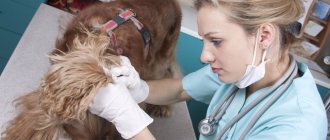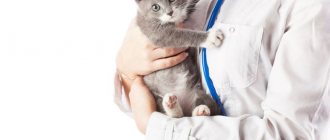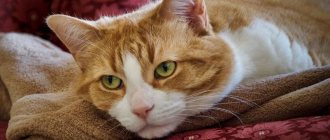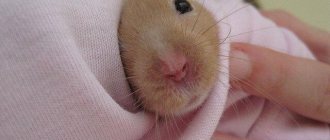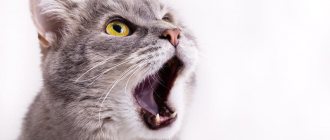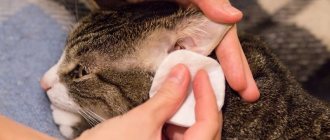(Be the first to vote!)
5589564
12/14/2021 owner reviews 1,
We all know that cats shed, and that it's normal to have cat fur on your couch and clothes. However, it is important to know the difference between normal and abnormal hair loss. Thinning or hair loss in cats, also known as alopecia, on the back legs can be caused by a number of problems: fleas, allergies, bacterial infection or stress.
- Why do cats lose hair on their back legs? Fleas and other parasites
- Pain
- Allergies
- Stress and anxiety
Where do bald spots come from?
Alopecia is pathological hair loss in a specific area of the body.
Some cats have normal alopecia. For example, in the area from the eyes to the ears, hair grows there less often and owners often turn to the veterinarian on the topic: “my cat’s forehead is bald.” Pathological alopecia is one of the symptoms of dermatitis - inflammation of the skin.
- Allergy
- Skin and intestinal parasites
- Stress
- Hormonal disorders
- Infectious and fungal diseases
- Lack of some vitamins
So dermatitis can be considered a serious reason to visit the veterinarian, but for now let’s look at the existing diseases in more detail.
Allergic dermatitis
In fact, cats have terrible allergies. An allergy may be to:
- Chicken
- Pork
- Cereal feed components
- Cleaning agent
- Filler
- Drugs
And much more.
The allergy is manifested by severe shedding, ulcerations on the skin, scratching and restlessness of the cat. A runny nose and lacrimation appear for the second time.
Cats with allergies are prescribed medicated food for life. The most popular are the food from the Royal Canin and Hills line.
Skin and intestinal parasites
Skin fleas include fleas. They bite the animal and cause discomfort, and the cat begins to itch intensely. The hair follicles are injured from such pressure, and the hair falls out, and scratches appear on the exposed skin.
Fleas do not live on the cat itself, but only on the litter. But dark spots of bites are visible on the pet’s body. Favorite places for fleas are the chin, base of the tail and lower abdomen.
In the presence of internal parasites, cats do not tend to tear off their skin, but their fur falls out intensively. Simply because there are not enough nutrients for hair.
Treatment involves treating the cat for parasites.
Stress
A cat experiences severe stress if:
- A small child appears in the house
- Other animals appear in the house
- Moving
- Long road
- Going to the vet
The fur flies off the animal's body quickly and rapidly, and if nervous tension continues for a long time, then bald areas appear on its body.
Treatment: eliminate the stress factor. If for some reason this is not possible, then the cat is prescribed sedatives or anti-stress food.
Hormonal disorders
Causes of hormonal imbalance:
- Change of seasons
- Estrus
- Taking hormonal medications, for example, during estrus or to stimulate it
- Disorders of the pancreas, thyroid glands and adrenal cortex
- Long-term use of non-steroidal anti-inflammatory drugs
Treatment consists of restoring hormonal levels, but before this the animal goes through a long journey of various diagnostic manipulations.
Fungal diseases
The most famous fungus is lichen. It is widespread, and you can only get sick when your immune system is severely weakened. It appears as bald spots on the face, with redness and peeling of the skin.
Diagnosed by pointing a Wood's lamp at the affected area.
It is treated by taking antifungal agents on the skin itself and internally.
The cat has lost hair on his belly
Recommended Posts
The cat's belly hair fell out, leaving only a short fluff. A “bald patch” has formed in the form of a triangle. The skin under the fluff is clean, pink, dense to the touch, there are two papillae on the sides. We noticed this about a month and a half ago, apparently he went bald at the end of summer.
The cat is 13 years old, no breed, neutered, not vaccinated, has not been ill with anything, active and cheerful, pees every day, poops once a week. We feed him all his life raw fish and meat, cucumbers, sometimes peas, etc., in the summer, grass from the street. Kitiket once a week. Doesn't go outside, only taken out a couple of times all summer.
“Yes, there is such an opinion among our brother. Not everything is so simple; very often even a good doctor underestimates diet therapy. In this matter I adhere to the opinion of BSAVA - the British Association of Small Animal Veterinary Medicine. This is, so to speak, a globally recognized brand of approach in global veterinary science.
Let me give you this example: So you give a cat a raw egg, a very healthy product, both proteins and fats and amino acids, but the egg contains avidin, which is killed by biotin, by the way, this can be the cause of baldness. Or you give your cat vitamin B1 and sea fish, such as cod, or just fish oil, which is healthy, but sea fish and fish oil contain the enzyme thiaminase, which simply breaks down vitamin B1. These substances are called antivitamins and are sometimes found in healthy foods. And the type of feeding that you use is called unbalanced feeding. In addition to antivitamins, many minerals compete with each other in the body, for example calcium with phosphorus, etc. The result of their mutual competition is a violation of bone mineralization in kittens, the so-called juvenile osteopenia of kittens.
Well, in the end, you must agree that those who advocate for straight women do not take into account that porridge and the whole list of that horror
Source
Diagnosis of alopecia in different parts of the body
Only a doctor can determine why a cat is going bald. The basis of diagnosis includes medical history, visual examination, and microscopic examination of hair roots.
The pet's blood is examined and a scraping is taken from the skin. If a tumor is suspected, an x-ray or ultrasound is performed.
The diagnosis is partially helped by the localization of bald spots on a cat:
- Symmetrical baldness of the abdomen, thighs, sides, and front legs is a characteristic symptom of a skin disease.
- Due to stress, cats tear out hairs in the anus, on the back, paws, stomach, and inner thighs. This happens especially often in the following breeds: Siamese, Abyssinian, Himalayan.
- Hormonal disorders are usually indicated by alopecia on the bridge of the nose, base of the tail, hips, and chest. The skin ceases to be elastic.
- In the case of a lack of thyroid hormones, pet hair is easily pulled out in the pelvic area, on the stomach, chest and neck.
- Cancerous formations provoke bald spots on the stomach, chest, and paws. Oncology can cause complete hair loss.
- Vitamin deficiency is characterized by the appearance of small, round bald patches, which can unite. The skin in places where there is no fur is bright pink.
- Fungal infections are characterized by the appearance of bald spots with scaly, cracked skin.
Scratching a pet's skin is dangerous due to infection and the development of an inflammatory process.
To make it easier for you to determine the cause of your pet's baldness, we have prepared a table. It contains all the main pathologies accompanied by hair loss in a cat:
Reasons for the appearance of bald spots in cats
Usually, due to illness or other physiological disorders in the animal's body, a bald spot remains on the neck, near the hind legs. Only after an examination at a veterinary clinic can the causes of baldness in cats be determined.
- Cat baldness can appear due to allergies to medications, certain types of food or products, or to hair care products.
- The fur sometimes peels off due to insect bites , but not all cat owners know about this. Flea bites may not go away without leaving a trace, although they are considered something minor.
- If your furry pet's back or other part of the body is peeling, this may indicate that the animal has experienced severe stress - fright, for example, or moving to a new place of residence.
- Among the causes of baldness are endocrine diseases, abdominal trauma, and pyoderma .
- Among the specific causes is feline symmetrical alopecia .
It is necessary to ensure that the cat does not lick the fur on its belly and paws too diligently and often; this can also cause damage to the hair follicles, their weakening, and hair loss.
What is flaking and how does it manifest itself in bald people?
Peeling is the formation of scales (squama), keratinized pieces of the epidermis. The separation of keratinized particles of the epidermis occurs constantly and is a normal physiological process, that is, the skin is renewed. With various skin diseases, this process intensifies. Scales can be separated either in very small (pityriasis-like) pieces or in plates. Depending on the underlying disease, the skin may be swollen, hyperpigmented, or, on the contrary, thin out and become almost transparent and reddish.
As we can see, flaking in Sphynx cats can be caused by a variety of factors, so it is necessary to make a diagnosis after a comprehensive examination of the cat. At home, if there are no other lesions on the skin besides peeling, you can try changing your skincare products and being more attentive to your cat’s hygiene. If there is no positive dynamics, try to make an appointment with a dermatologist. The doctors at our veterinary clinic will carefully examine your pet, perform a series of diagnostic tests to identify the cause of the flaking, and prescribe the optimal treatment.
Treating a cat for parasites
Treatment must be prescribed by a doctor. Most often, complex spot-on preparations (pipettes with medicine on the skin) are prescribed in an intensive mode - every 10-14 days. The most commonly used are “Stronghold” and “Inspector”. In case of skin infection, the doctor will prescribe local treatments with antiseptic solutions and even antibiotics. Recently, information has appeared about the effectiveness of the Bravecto tablet used in dogs in cats. Studies have already been conducted and safe doses for cats have been determined. However, there is no information in the instructions yet, but it will probably appear very soon.
One area of the body is going bald
Baldness in the area of the hind legs most often occurs with liver lesions.
If only one area is balding and there are no visible reasons for this, you should urgently consult a doctor for a full comprehensive examination.
Possible factors causing alopecia:
- allergic reaction to medications, food, dangerous contacts;
- damaged hair follicles;
- injuries;
- stress;
- failure of endocrine processes;
- liver diseases;
- avitaminosis.
Avitaminosis
For normal functioning, the cat's body requires a complex of vitamins.
For normal functioning, the cat’s body, like the human body, requires the entire complex of vitamins and minerals, and the lack of them provokes various pathological processes. A lack of vitamins of a certain group is manifested by specific symptoms characteristic of this particular pathology.
Alopecia
A lack of B vitamins in the body can cause periodic vomiting in a cat.
- Along with the main symptom, there is a disorder of the digestive system in the form of periodic vomiting.
- Signs of dysfunction of the nervous and muscular systems appear.
- The animal is weak, lethargic, has an unsteady gait, and a sharp loss of weight.
- Global deficiency of vitamin B1 is expressed by paralysis and convulsions.
- Eliminated by eating more raw meat, bone meal, and yeast.
- Among other things, replenishment is required through the use of special vitamin preparations.
- Deficiency of vitamins B2 and B5 is manifested by cracks in the mucous membranes, slower growth of babies, decreased heart rate and body temperature.
- Eliminated by consuming dairy products and foods of plant origin.
- A lack of vitamin B12 manifests itself in more serious complications such as constipation, urination problems, enlarged liver and spleen, and intestinal colic.
Help only under the supervision of a veterinarian.
Cirrhosis of the liver
Liver cirrhosis in a cat.
As a result, a malfunction occurs, and subsequently a complete failure of all functions of the organ. There are several reasons for the appearance of this pathology.
Primary factors
Primary factors are most often caused by gradual intoxication of the body and, as a result, a large accumulation of toxins in the liver. Another reason that led to cirrhosis is hypovitaminosis of group B. With this pathology, symptoms appear after some time, as a result of the action of some aggressive factor. Provoking factors are also the failure of metabolic processes and hereditary predisposition.
Lack of food containing B vitamins can lead to cirrhosis of the liver.
Secondary factors
Infectious or invasive diseases and pathologies of the cardiovascular system act as secondary aggressors.
Infectious diseases can cause cirrhosis.
Signs
- For a long time, the only sign of cirrhosis may be the pet’s baldness in the abdomen and hind legs.
- Further, as the disease progresses, the abdomen becomes enlarged, which may indicate ascites.
- The cat looks tired, shows apathy and aggressive reactions to any attempts at contact.
- Decreased appetite, weight loss, and severe thirst.
- Frequent urination.
- In the final stages, convulsions, loss of coordination, and decreased vision are noted.
An enlarged abdomen may indicate ascites.
Treatment and therapy
Treatment is aimed at maintaining the heart and stopping the progression of the disease. If you refuse to eat, force-feeding is used using a drip infusion of glucose solution. Vitamin therapy and diuretics are prescribed.
If you refuse to eat, feeding with a drip solution is used.
Endocrine focal symmetric alopecia
Like most pathologies, it cannot arise independently and there are quite a lot of provoking factors: hypothyroidism, hyperfunction of the thyroid gland, hyperfunction of the adrenal cortex, diabetes. As a rule, symmetrical baldness is not accompanied by itching, although in the presence of allergic reactions such a phenomenon is quite possible, but in very rare cases.
As a rule, baldness is not accompanied by itching.
Treatment
Treatment depends on the identified pathology and is applied strictly under the supervision of a veterinarian. The owner’s only comprehensive help is timely contact with a specialist.
Treatment should be strictly under the supervision of a veterinarian.
Problems with the endocrine system
Alopecia, caused by disturbances in the endocrine system of cats, is not so rare. The specific endocrine disease may vary. Additional symptoms of hypothyroidism are lethargy, sometimes obesity, and decreased body temperature.
With hyperfunction of the adrenal cortex, swelling appears. What bald cats look like due to the endocrine system can be seen in the photos of special sites about feline health; accurate illustrations will help owners quickly recognize the disease in order to begin its treatment.
How to treat baldness
How to treat alopecia largely depends on the diagnosis. Many mustachioed owners, when they see a bald area, scream in horror - “deprivation!” and begin to look for something to anoint. The approach is completely wrong.
For feline alopecia, complex treatment is most often prescribed. Local therapy is indicated if there is a bacterial or fungal infection.
The algorithm is as follows:
- Treatment of the underlying disease that causes hair loss in cats.
- If skin parasites are identified, drops, tablets, and shampoos are prescribed to get rid of them. The prognosis is good if antiparasitic treatments are carried out regularly.
- For infections, a course of antibiotics.
- In case of an allergic reaction, the allergen is eliminated. If your cat has a food allergy, review the diet and eliminate it. The prognosis is good if the food is chosen correctly. If the allergen is not identified, the prognosis for recovery is cautious.
- If it's stress, the cause should be ruled out. With proper behavior correction, the prognosis is satisfactory. The therapy is long-term and requires patience from the owner.
- If tumors occur, surgical intervention is required. Timely surgery gives the right to make a positive prognosis. In advanced cases, the animal is not operated on.
Regardless of the reason, it is additionally necessary to strengthen the animal’s immunity. Sometimes the question arises about selecting a diet in accordance with age, state of health, and physiology.
Causes of alopecia
Baldness of a cat's paws is observed mainly when:
- avitaminosis;
- allergic reactions;
- the presence of ectoparasites;
- endocrine disorders;
- liver and kidney diseases.
Excessive hair loss in a pet, which occurs as a result of a lack of vitamins (the symptom is especially pronounced with vitamin B deficiency). In this case, alopecia is accompanied by periodic vomiting, slower growth and weight gain, and disruption of the muscular and nervous systems.
Allergies in cats most often occur to components of food or litter. With a specific immune response, in addition to baldness of the paws, skin hyperemia, the appearance of peeling and rashes are noted.
Ectoparasites (fleas, ticks) cause severe itching of the skin, as a result of which the cat constantly itches and licks itself and baldness is observed in these areas.
Endocrine pathologies occur mainly in castrated and sterilized cats, since after removal of the glands that produce sex hormones, shifts are noted and the balance of hormones is disturbed.
Liver diseases develop as a result of constant intoxication of the body, diseases of the cardiovascular system, hereditary predisposition, group B hypovitaminosis, as well as some invasive or infectious diseases. Most often, the answer to the question of why a cat’s belly and hind legs go bald is liver disease – mainly cirrhosis.
Causes of skin diseases in cats
Poor care, poor diet, stress, medications, plastic bowls - in veterinary medicine, animal skin diseases can be caused by various reasons. When a pet is sick or frequently encounters an irritant (eg, an allergen), its immunity weakens. She becomes vulnerable to opportunistic organisms that always live in her body (for example, dermatitis mites) and do not normally appear.
Other causes of skin diseases in cats:
- allergies to food, inhaled compounds, flea bites and other substances with which the pet comes into contact;
- communication with sick animals;
- fungal infections;
- bacterial disease of the hair follicles;
- trauma, skin damage, causing inflammation or abscess;
- adverse reactions to medications;
- fleas, ticks;
- hormonal imbalances.
Skin diseases of cats: general symptoms
There are a number of symptoms of skin diseases that will indicate a problem, regardless of the cause:
- severe itching;
- hair loss, bald patches;
- redness;
- dryness, peeling, scabs;
- dull coat color.
The animal constantly itches, scratches, and chews its skin to reduce the pain of symptoms of skin diseases in cats. She may also lick the fur too much to soothe the irritated coat.
Food allergy in cats: symptoms and treatment (photo)
Most often, a variety of food products act as allergens. Among them:
- sweets;
- bright vegetables and fruits;
- meat;
- dairy products (cottage cheese, sour cream, cream, etc.);
- eggs;
- corn.
At the same time, they can provoke irritation not only in their “pure” form, but also when they are part of dry food. For example, cheap economy-class products constantly contain cereals and vegetable cakes, as well as corn and harmful additives that can lead to an allergic reaction.
All cat owners should closely monitor the condition of their pets and stop thoughtlessly overfeeding animals with natural products and poor-quality “drying” at the first signs of deterioration in their pet’s well-being. Warning signals cannot be ignored. If you can't find the source of the problem on your own, go to the vet.
Symptoms of food allergies:
- wet eczema on the neck, abdomen, inner thighs;
- severe itching;
- discharge from the eyes and nose;
- in some cases, severe hair loss in the affected areas is possible;
- swelling of the larynx and difficulty breathing (if this symptom appears, urgent veterinary assistance is required).
The following treatment is possible, carried out exclusively under the supervision of a doctor:
Purpose of a special diet - the cat is transferred to a special food, all natural products are excluded from the diet.
Use of antibiotics as prescribed by a specialist.
Daily treatment of affected areas with special preparations that have a disinfectant and antimicrobial effect.
A bath with a special shampoo together with treating the animal against ectoparasites.
After completing the course of treatment, it is necessary to bring the animal back to see the attending physician. As a rule, after severe allergic reactions to natural food, the cat is switched to dry food, selected taking into account the individual characteristics of the body.
Only a doctor can tell you how to treat a cat’s allergies. Therefore, if your pet rubs against all corners and cannot find relief from the itching, and its skin is covered with wounds and begins to get wet, immediately go to an experienced veterinarian. Remember: the health of your beloved purr is in your hands.
What causes a cat to go bald, what happens to it
Cats go bald for various reasons.
These include:
pregnancy or stress. During pregnancy, lactation, or due to severe stress, a cat may begin to lose fur. But there is no need for treatment; after a while it will grow again;
- baldness above the eyes. At the age of 14 to 20 months, cats, especially dark shorthaired cats, begin to lose hair above their eyes. This process is natural and, if there is no redness, treatment is also not required;
- side effect of the medicine. Sometimes baldness occurs after taking medications;
- consequences of the injection. Sometimes baldness occurs in the area where the injection was given after a couple of months. In addition, there may be skin thickening and hyperpigmentation. Everything also goes away on its own;
- fleas. There are varieties of fleas that cause baldness.
- ringworm. Signs (in addition to hair loss): peeling of the skin, the appearance of crusts, and sometimes itching;
- allergy/contact dermatitis. It happens that a cat develops an allergy from antibiotics or some food component, as well as from interaction with certain materials, metals, and chemicals. In addition to hair loss, redness, bumps, and itching occur;
- solar dermatosis. This reaction to sunlight usually occurs in white cats. It goes away on its own (although the animal will need to avoid sunlight), but sometimes medications are also necessary. Symptoms: hair falls out, redness occurs, crusts and sores appear on the nose and ears;
cheyletiellosis. The causative agent is a tick. The cat itches a lot, but if the disease has not worsened significantly, hair loss is usually minimal;
Important! Ticks easily climb onto other animals and even people.
folliculitis. Infectious disease of hair follicles, occurring on the face, neck, head, accompanied by itching, hair loss;
hyperthyroidism. It happens due to increased secretion of thyroid hormones. With this disease, the fur is easily pulled out and falls out profusely, the cat itches and licks a lot, which causes irritation on the skin;
neurogenic dermatitis. Due to stress, anxiety, or boredom, a cat may lick itself a lot. As a rule, fur loss is symmetrical. To heal, you need to understand the cause of the stressful condition;
alopecia areata. An autoimmune disease that goes away on its own. Fur falls out on the head, neck, body (without itching).
- seborrhea. It can be congenital or acquired (after feline leukemia virus, infectious peritonitis, feline immunodeficiency virus, ringworm, parasites). It manifests itself in different ways: scales appear on the skin, the fur becomes very dry/oily, an unpleasant odor occurs, hair loss occurs;
- hyperadrenocorticism. Caused by elevated levels of corticosteroids (occurs not only for natural reasons, but also as a result of prolonged hormonal treatment). Signs: baldness, thinning of the skin, hyperpigmentation, comedones, bruises;
demodicosis (glandular acne). A tick-borne infection that affects the face and neck. If demodicosis is generalized, this indicates immunodeficiency. Symptoms: baldness, the appearance of scales, redness, itching;
polymorphic erythema. It appears due to increased sensitivity to a medication or infection, and may be one of the manifestations of oncology or other diseases. There is loss of fur, blisters (near the mouth, ears, groin, armpits), and sometimes ulcers. Sometimes the temperature rises and apathy appears.
Important! There are many causes of baldness and medications are not always necessary. But still, do not self-treat; be sure to take your pet to a veterinarian for an accurate diagnosis.
Description and symptoms of the disease
Alopecia or baldness is the loss of fur in cats. Bald patches and bald spots above the eyes, on the stomach, on the back, heel and hind legs indicate the development of diseases in the pet, although the reason why these parts of the body are bald cannot always be identified. But doctors tend to believe that the animal is going bald due to psychological problems. In this case, the animal loses hair only in small quantities or en masse. The cat becomes bald at the tail or just at the tip, on the head, back, legs, heels and behind the ears. The disease in a kitten is accompanied by itching and pain at the sites of injury. The cat's fur is falling out in clumps or has become bald. The skin in these areas becomes dry and flaky. Redness or sores may appear.
Varieties
According to the candidate of veterinary sciences A. N. Gerke, which is set out in the scientific work “Diagnostic approach and therapy for non-inflammatory alopecia in cats,” the most common type is self-induced baldness. This type of disease appears when the cat begins to lick its fur on its own to the point of becoming bald and mangy. The back legs or the area near the head are especially affected when the kitten scratches its neck. In such cases, the animal does not experience discomfort and allows you to touch the damaged areas. There is also symmetrical alopecia - hair loss in cats of the same size in different parts of the body. In addition, there is a random form, when the cat’s hair falls out unevenly and the bald spot is located in several areas.
Scientific work of A.N. Gehrke
Causes of the disease
At the site where ringworm appears, the animal's hair falls out and severe itching is felt.
The most common source of disruption is stress. Cats are especially susceptible to this during pregnancy or lactation. Then the cat becomes bald on its stomach and legs. Alopecia in cats occurs as a side effect of the use of medications, such as antibiotics. Also, bald spots in cats develop after injections at the injection sites. If your cat's ears and heels are going bald, this could be a sign of ringworm. Then the bald spot becomes crusty, very itchy and flaky.
Alopecia in cats occurs due to the spread of fleas or ticks throughout the pet's body. Another common cause is allergies to environmental objects: food, metals, chemicals. Then red baldness and dryness appear. A cat's hair falls out in clumps due to solar dermatosis. White individuals are prone to this violation. As a result of the pathology, they develop sores, wounds near the eyes, nose and ears, and the tail becomes peeling. A cat's tail peels off (either completely or just the tip) due to seborrhea. This type of disease can be congenital or acquired. The disease is accompanied by an unpleasant odor, the skin becomes oily or dry, scales or a red spot form on the belly or withers. If you see bald patches above the eyes of a cat with short hair at the age of 14-20 years, then there is no need to worry too much. This is a natural phenomenon and does not require treatment.
There are such reasons why fur falls out and a bald spot appears on the stomach and hind legs:
- cheyletiellosis;
- folliculitis;
- adenitis;
- hyperthyroidism;
- neurogenic dermatitis;
- nesting baldness;
- seborrhea;
- hyperadrenocorticism;
- demodicosis;
- diabetes;
- adrenal gland diseases;
- erythema.
Psychogenic alopecia
Hair loss in cats can be psychogenic in nature. That is, the cause in this case is obsessive behavior. For no apparent reason, a completely healthy, well-fed and well-groomed cat goes bald in a short time. With careful observation, the owner may notice some features: the cat is overly preoccupied with grooming procedures.
When a cat constantly licks, bites and pulls out fur, it not only violates the integrity of the coat, but also injures the skin. In bald areas, areas of redness, sores and sores may form. To get rid of the pain, the animal licks the injured areas even more, which only worsens the situation.
This behavior is called biased. If a cat is in a stressful situation for a long time, for example, he cannot catch a bird outside the window, or is limited in physical activity, he shifts the action to himself, as if he is self-soothing. The most common expression of biased behavior is “self-grooming.”
The reasons that cause psychogenic baldness can be very different:
- Isolation and limitation of physical activity.
- The appearance of a new member in the family - it can be a new pet or a newborn baby. The focus of attention shifts to the “new guy,” and this fact causes negative emotions in the cat.
- Separation from owner or family members.
- Repair or relocation.
- Boredom.
These problems can be avoided if you pay enough attention to the cat: play with it often, caress it, provide conditions for normal physical activity, and take care of its psychological comfort.
How to prevent hair loss in your hind legs
Not all causes of hair loss in cats can be prevented. However, you can take steps to keep your cat as healthy and happy as possible.
- Make sure your cat's personal stressors—whether environmental changes or another animal—are kept to a minimum so she doesn't resort to over-grooming out of frustration.
- Provide a nutritious diet, plenty of exercise, and regular veterinary checkups to avoid serious health problems.
- Give your cat an effective flea preventative monthly to prevent parasite infestations that can cause hair loss.
- Keeping your cat indoors will also reduce the likelihood of it becoming infected with many ticks.
Cats can lose hair on their back legs for a variety of reasons. The first step in treatment is to find out the underlying cause of hair loss on the hind legs. If you notice that your cat is losing hair, take her to the vet. The sooner the cause is diagnosed, the faster the cat will feel better and the fur will grow back.
Author of the article: Dr. Monica Tarantino . Small animal veterinarian in Charlotte, NC with five years of experience as a veterinarian. Dr. Tarantino often rescues pets in need and owns four dogs.
Baldness treatment
Depending on the root cause of the baldness of the cat’s paws, an appropriate therapeutic regimen is selected.
- In case of vitamin deficiencies, it is necessary to adjust the diet and add special vitamin and mineral complexes to the diet of a cat who is severely balding.
- In case of allergies, it is enough to eliminate the foreign protein and the pet’s fur will become shiny and thick again.
- If the cause of baldness of the paws is ectoparasites, then it is necessary to get rid of them with the help of special veterinary drugs and the cat’s coat will be restored.
- When a cat goes bald due to endocrine disorders, treatment consists of prescribing hormonal medications to the pet.
- For liver pathologies, maintenance therapy is prescribed, which will eliminate intoxication of the body, help the liver cope with its functions, and also prevent the progression of the pathology and the development of secondary diseases.
When a cat becomes bald on its stomach near its paws, it is very important to correctly diagnose and choose treatment. Otherwise, the animal’s condition may worsen and, in addition to baldness, there will be loss of appetite, depression, impaired coordination, vision, and convulsions.
Why does a cat's belly go bald?
Representatives of the cat family are characterized by periodic renewal of their coat. But if large bald patches become noticeable on the animal’s body, the owners need to worry about the health of the tailed animal. Baldness is otherwise called alopecia. With this pathology, cats may experience large amounts of hair loss all over their body and on their paws.
If a cat's belly is severely balding, this may indicate a malfunction of some organ or system of the body. It is also worth noting that alopecia is usually not an independent disease, but only signals the appearance of some other pathology.
Symptoms
Even an inexperienced owner will be able to determine the moment when his cat begins to go bald. During this period, the amount of animal fur in the apartment increases, and bald patches appear on parts of the pet’s body.
You can try to identify the causes of baldness on your own. To do this, you need to carefully examine your pet's skin. With some diseases, the animal may develop a characteristic itching. Your cat may often scratch the bald spot. More serious illnesses appear as sores, scabs, or peeling skin. In some cases, small bumps may appear.
Even if there are no visible reasons for a cat to have hair growing on its belly, it is necessary to take the animal to a veterinarian for a comprehensive examination.
Diagnostics
It's not always easy to understand why a cat suddenly started going bald. Usually the exact cause of the pathology is established by excluding all possible causes for baldness.
It is worth carefully examining the animal, paying special attention to the abdomen, hind and front legs. It is necessary to assess the condition of hairs in the coat
Also estimate how large an area is affected by the patch of baldness. Is there a border to the bald area, or has the animal’s coat simply thinned out? It is necessary to exclude infectious and fungal infections of the skin.
If your cat has recently had surgery, alopecia may occur at the site of the suture. Sometimes hair falls out in areas of the body where the animal has been injected with medications.
Diagnostic methods
After conducting an examination, the veterinarian will prescribe treatment according to the reasons that provoked the problem.
It is not recommended to self-medicate. As soon as your cat's fur begins to peel off, you should contact your veterinarian. He will conduct a series of studies to identify the cause of alopecia and prescribe therapy. First, the doctor learns about how the animal eats, where it lives and how often it goes outside. This helps to identify the source of the pathology. Next, he examines the cat, checking the condition of the hair using a microscope. The pet must undergo blood tests, hormone tests and scrapings to find out why the cat is bald and shabby. To identify the development of disorders of internal organs, it is necessary to do an ultrasound examination or radiography.
Examination by a veterinarian and diagnosis
The effectiveness of treatment depends on an accurate diagnosis. As mentioned above, you should definitely contact a special clinic. Prescribing medications yourself is very dangerous. From such “treatment” the cat may lose all its fur.
At the veterinary hospital, your pet will be able to undergo the necessary examinations. One of the main tests is a trichogram. Thanks to it, they receive information about the condition of the coat, making the first conclusions about the causes of the disease.
To care for a cat, you need to know what a furminator is for, whether cats need clothes, everything about mating cats, how to choose a comfortable carrier, whether you need to sterilize a cat, how to trim a cat’s claws, how to make toys for a cat with your own hands, how to give birth to a cat how to make a scratching post.
Did you know? Smuggling cats from ancient Egypt was punishable by death.
How to treat the disease?
To quickly cure a cat, you need to know the source of the disease and why the cat’s hair came out. If a cat suffers from baldness due to allergies, then the owner must protect the pet from the irritant. Afterwards, the cat is prescribed histamines, immune system stimulants and hypoallergenic products. If the source is parasites, then bald spots on the tail, back, and legs are treated with ointment against ticks or fleas. In addition, the veterinarian prescribes medications that improve the functioning of the immune system. For endocrine diseases, drugs are used that restore the action of the glands. If alopecia in cats is caused by an abscess, then antiseptics and antibiotics are prescribed.
Prevention
Problems when a cat has bald ears, belly, peeling heels, back or tail at the base arise quite often, but they are quickly treated. But in order not to injure the animal, violations should be prevented. To prevent the appearance of alopecia, veterinarians recommend monitoring the hygiene and nutrition of the animal. The cat must be kept in clean conditions so that it does not get infected. In order to identify violations in time, it is advised to regularly consult a doctor and independently check the condition of your pet’s skin. This will allow you to find out at the first stages of the development of the pathology why the fur is coming out and remove the disease. If hair falls out on the ears or the back becomes bald, you cannot treat it yourself, so as not to worsen the condition of your pet.
Baldness treatment
Depending on the root cause of the baldness of the cat’s paws, an appropriate therapeutic regimen is selected.
- In case of vitamin deficiencies, it is necessary to adjust the diet and add special vitamin and mineral complexes to the diet of a cat who is severely balding.
- In case of allergies, it is enough to eliminate the foreign protein and the pet’s fur will become shiny and thick again.
- If the cause of baldness of the paws is ectoparasites, then it is necessary to get rid of them with the help of special veterinary drugs and the cat’s coat will be restored.
- When a cat goes bald due to endocrine disorders, treatment consists of prescribing hormonal medications to the pet.
- For liver pathologies, maintenance therapy is prescribed, which will eliminate intoxication of the body, help the liver cope with its functions, and also prevent the progression of the pathology and the development of secondary diseases.
When a cat becomes bald on its stomach near its paws, it is very important to correctly diagnose and choose treatment. Otherwise, the animal’s condition may worsen and, in addition to baldness, there will be loss of appetite, depression, impaired coordination, vision, and convulsions.
Principles of treatment
When starting to treat allergies, it is necessary to identify the allergen.
Reactions to flea and other insect bites can be eliminated by local treatment of the skin and hair with insecticidal agents. Particularly popular are drops on the withers - Bars, Barrier-super, Frontline.
Food allergies are eliminated by eliminating hazardous foods from the diet and prescribing antihistamines. Dust – creating conditions for a comfortable living of the animal: regular wet cleaning of the premises, cleanliness of the habitat.
Atopic dermatitis, due to the genetic nature of the disease and its chronic long-term course, is treated throughout life using maintenance therapy and the prevention of secondary pathologies.
The most common disease of the pancreas is pancreatitis. Since baldness can occur only with severe pancreatitis, treatment consists of intensive care, namely:
- elimination of pain – antispasmodics, painkillers, anesthetics, analgesics;
- combating dehydration - saline, colloidal solutions, droppers, injections;
- reduction in the production of destructive secretions - atropine and analogues;
- relieving edema and slowing down pancreatic functions - hormones, ribonuclease;
- removal of intoxication;
- severe case - surgical intervention.
Following a diet containing foods that have enveloping properties is mandatory.
Pyoderma and bald spots.
Help for pyoderma consists of a complex of therapeutic measures: local treatment, oral medication, injections, herbal medicine. For local treatment, anti-inflammatory gels, tinctures, streptocidal ointment, Cefakure, Maxidin are prescribed.
Antibiotics – Tylozolin, Lincomycin hydrochloride, Clindomycin, Cephalexin, Erythromycin. Gamma globulins, Staphylococcal anatoxin, Evinton, Neoferon, Bactoneotim. Healing drugs – Gamavit, Katazol.
Herbal medicine – chamomile, celandine, calendula, sage, eucalyptus.
Hyperthyroidism
The goal of treatment for hyperthyroidism is to reduce the level of thyroid hormones in the blood.
There are two main treatment methods available: drug support throughout the entire life cycle and surgical removal of the gland. Long-term use of medications that inhibit the production of thyroid hormones containing thiourea is indicated. Medicines that support the functioning of the heart and the entire vascular system. Medicines that support kidney function.
Treatment of hypothyroidism comes down, first of all, to replenishing the deficiency of the hormone that led to the disease. The main drug prescribed for pathology is Levothyroxine sodium. The dose is selected individually for each animal, depending on the existing deficiency and body weight. The course for complete recovery is designed for four weeks of use. At the same time, we can take drugs that slow down the binding of serum proteins - glucocorticoids, salicylates.
